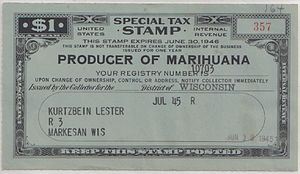Main articles: Marihuana Tax Act of 1937 and Hemp
| Marihuana Tax Act of 1937 |
|---|
| The Marihuana Tax Act of 1937 made possession or transfer of cannabis illegal throughout the United States under federal law, excluding medical and industrial uses, in which an expensive excise tax was required. Annual fees for the tax were $24 ($337 adjusted for inflation) for importers, manufacturers, and cultivators of cannabis, $1 annually ($14 adjusted for inflation) for medical and research purposes, and $3 annually ($42 adjusted for inflation) for industrial uses. Detailed cannabis sale logs were required to keep record of cannabis sales. Selling cannabis to any person who has previously paid the tax is $1 per ounce or fraction thereof; however, it is $100 ($1,406 adjusted for inflation) per ounce or fraction thereof to sell any person who has not registered and paid the special tax.[29] |
The decision of the United States Congress to pass the Marihuana Tax Act of 1937 was based on hearings and reports.[35][36] In 1936 the Federal Bureau of Narcotics (FBN) noticed an increase of reports of people smoking marijuana, which further increased in 1937. The Bureau drafted a legislative plan for Congress, seeking a new law and the head of the FBN, Harry J. Anslinger, ran a campaign against marijuana.[37][38] Newspaper mogul William Randolph Hearst's empire of newspapers began publishing what is known as "Yellow journalism", demonizing the cannabis plant and putting emphasis on connections between cannabis and violent crime.[39] Several scholars argue that the goal was to destroy the hemp industry,[40][41][42] largely as an effort of Hearst, Andrew Mellon and the Du Pont family.[40][42] They argue that with the invention of the decorticator hemp became a very cheap substitute for the paper pulp that was used in the newspaper industry.[40][43] They also believe that Hearst felt that this was a threat to his extensive timber holdings. Mellon was Secretary of the Treasury and the wealthiest man in America and had invested heavily in nylon, DuPont's new synthetic fiber, and considered its success to depend on its replacement of the traditional resource, hemp.[40][44][45][46][47][48][49][50] According to other researchers there were other things than hemp more important for DuPont in the mid-1930s: to finish the product (nylon) before its German competitors, to start plants for nylon with much larger capacity, etc.[51]
In 1916 United States Department of Agriculture (USDA) chief scientists Jason L. Merrill and Lyster H. Dewey created a paper, USDA Bulletin No. 404 "Hemp Hurds as Paper-Making Material", in which they concluded that paper from the woody inner portion of the hemp stem broken into pieces, so called hemp hurds, was "favorable in comparison with those used with pulp wood". Dewey and Merrill believed that hemp hurds were a suitable source for paper production.[52] In 2003 95% of the hemp hurds in EU were used for animal bedding, almost 5% were used as building material. In addition 70–80% of hemp fiber produced was used in specialty pulp for cigarette papers and technical applications; hemp is not reported as source for mass production of newsprint.[53]
In 1916 the United States Department of Agriculture assumed, partly based on the incorrect finding about hemp hurds of USDA Bulletin No. 404, that the production of hemp would rise in the US. In reality production fell until 1933, due to competition with other fibers and imports. In 1933 production was only around 500 tons of hemp fiber per year. 1934–1935 the cultivation of hemp began to increase, but still with a very low volume compared with other types of fibers and with no significant increase in production of paper from hemp.[54]
There was also a misconception about the intoxicating effects of hemp because it has the same active substance, THC, which is in all cannabis strains. Hemp normally has a minimal amount of THC when compared to recreational cannabis strains but, in the 1930s, THC was not yet fully identified.[55] The methods FBN used for predicting the psychoactive effect of different samples of cannabis and hemp therefore gave confusing results.[56][57]


So, Big Business Is the main reason for the illegalization!!!! Afraid of Competition!!!
ReplyDelete